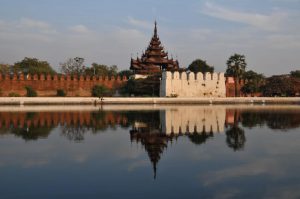Security forces backed by armored vehicles clashed yesterday with a newly formed guerrilla group in Mandalay, Myanmar’s second-biggest city, marking the first time that such a clash has taken place in a major urban center.
The shootout reportedly began after Myanmar soldiers raided a building where members of a civilian militia group were sheltering. According to Mandalay residents quoted by local media outlets, the troops fired machine guns and grenades after the group resisted arrest, whereupon other militia members came to their comrades’ aid.
Since the military’s seizure of power on February 1, civilian militias have sprung up across the country to take on the Myanmar armed forces, or Tatmadaw, after nationwide protests were met with violent repression by the new military government. As of yesterday, at least 875 people had been killed since the coup and more than 6,000 arrested, according to the Assistance Association for Political Prisoners, a local advocacy group.
Many of these new people’s militias have pledged their support to (and often taken the name of) the People’s Defense Force (PDF) that was formed last month in order to protect protesters from junta attacks and form the eventual nucleus of a new federal army. They have also declared their loyalty to the National Unity Government that was formed in April by ousted parliamentarians and the representatives of ethnic minority organizations.
Until now, fighting between lightly armed militias and junta troops has been concentrated mainly in small towns and rural areas, such as Mindat township in Chin State, which saw an upswing of militia activity that prompted the Tatmadaw to take the town by force in mid-May. The Mandalay shootout was the first time the military and groups of armed civilians have fought in a major urban area.
The group involved in yesterday’s clashes calls itself the Mandalay People’s Defense Force, which, as per The Irrawaddy news site, was formed by local resistance fighters who underwent military training with ethnic armed groups. “The fight has started. There will be more fights,” a militiaman identified as Capt. Tun Tauk Naing told Reuters.
The exact number of casualties from the clash remains unclear. Myawaddy Television reported that eight civilians were killed during the shootout and eight arrested, while some junta troops were seriously injured. The Mandalay PDF said two of its members were killed and six arrested by security forces following the clash.
In earlier incidents in other parts of Myanmar, the army has responded with artillery and air strikes after civilian defense forces have launched attacks on soldiers. In some cases, these attacks have forced tens of thousands of people to flee their homes.
The coming of armed conflict to the streets of Mandalay, the country’s former royal capital, marks a significant escalation of the post-coup crisis. While Myanmar has experienced civil war for most of its 73 years as an independent nation-state, much of this has taken place in ethnic minority regions of the country, including remote regions along the Thai and Chinese borders. This latest clash, however contained, suggests the potential for Myanmar’s perpetual civil wars to coalesce into a generalized and truly nationwide struggle against the Tatmadaw.
The military’s violent crackdowns may have succeeded in halting the large-scale demonstrations that immediately followed the coup, but the junta’s opponents are clearly girding themselves for a long struggle.
Since the PDF’s formation at the start of May, an unknown number of civilians have received military training in border areas controlled by ethnic insurgents, wearing uniforms emblazoned with the PDF’s insignia, while other civilian defense groups have pledged their loyalty to the nascent army. Alongside the increasing armed civilian resistance, Myanmar has seen growing instances of unexplained bombings targeting local government offices or military-linked businesses.
None of these recent developments suggests that the military coup is bound to fail. But it does suggest that it will almost certainly fail to succeed in its aim of stabilizing and pacifying the country, heralding an indefinite period of instability and turmoil for one of the world’s longest suffering countries.

































